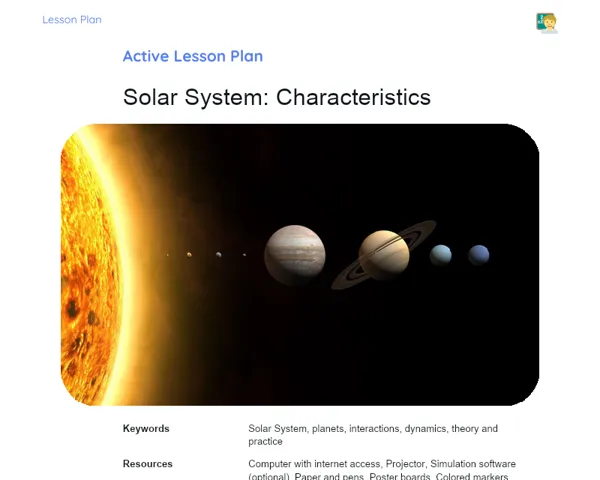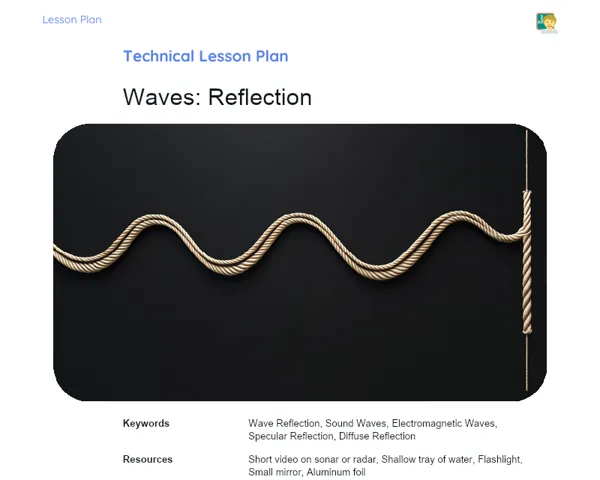Lesson Plan | Lesson Plan Tradisional | Electricity: Electric Field
| Keywords | Electric Field, Electric Force, Electric Charge, Field Lines, Electric Field Calculation, Superposition of Fields, Magnitude, Direction, and Sense, Practical Examples, Modern Technologies, Capacitors, Magnetic Resonance Imaging |
| Resources | Whiteboard, Colored markers, Multimedia projector, Presentation slides, Calculators, Note-taking sheets, Reference material with formulas and examples, Physics textbooks |
Objectives
Duration: 10 to 15 minutes
At this stage, our aim is to present a clear and comprehensive overview of what students should accomplish by the lesson's end. This will assist the teacher in structuring their explanation and ensure that all essential skills are effectively addressed, laying a robust foundation for grasping the concept of electric fields.
Objectives Utama:
1. Relate the generated electric field to the electric force.
2. Calculate the electric field produced by a specific charge.
3. Understand the magnitude, direction, and orientation of an electric field.
Introduction
Duration: 10 to 15 minutes
This stage aims to create a solid foundation for students by contextualizing the subject matter and demonstrating its practical application. This approach helps ignite students' interest and inquisitiveness, facilitating their understanding of the concepts that will be explored throughout the lesson.
Did you know?
Did you know that the concept of electric fields is central to the functioning of many modern gadgets? For instance, it's vital for the operation of MRI machines in hospitals that aid in medical diagnoses. Additionally, electric fields underpin capacitors, which store electrical energy and are found in nearly all electronic devices, ranging from mobile phones to computers.
Contextualization
To kick off the lesson on Electric Fields, it’s crucial to connect with the students on the electric forces they may already be acquainted with. Clarify that, similar to how gravitational force operates over space between two masses, electric force acts between charged particles. Emphasize that the electric field concept aids us in understanding how these forces propagate through space, even in the absence of direct contact between the charges.
Concepts
Duration: 55 to 60 minutes
This stage seeks to furnish a well-rounded and practical comprehension of electric field concepts, equipping students to apply these notions to real-world problems. By exploring varied topics and addressing practical questions, students will learn to relate electric fields to electric forces, calculate fields from different charges, and understand key characteristics of electric fields, such as magnitude, direction, and sense.
Relevant Topics
1. Concept of Electric Field: Clarify that an electric field is a region in which an electric charge feels a force. Connect the electric force (F) to the electric field (E) using the formula: F = qE, where q represents the charge.
2. Electric Field Lines: Explain that electric field lines are hypothetical lines depicting the direction of the electric field. Mention that these lines flow out from positive charges and into negative charges without crossing each other.
3. Electric Field of a Point Charge: Introduce the formula for the electric field created by a point charge: E = k * |Q| / r², where k is the electrostatic constant, Q denotes the charge, and r signifies the distance from the charge. Provide calculation examples.
4. Superposition of Electric Fields: Explain that the overall electric field at a point due to multiple charges is the vector sum of the separate electric fields. Offer practical examples to highlight this principle.
5. Magnitude, Direction, and Sense of the Electric Field: Demonstrate how to determine the magnitude, direction, and sense of the electric field in diverse scenarios, stressing the importance of understanding these attributes to tackle associated problems.
To Reinforce Learning
1. Calculate the electric field at a distance of 0.5 m from a charge of +3 μC.
2. Sketch the electric field lines for two equal and opposite charges (+Q and -Q) set apart by a distance d.
3. Find the resultant electric field at a point P equidistant from two equal +2 μC charges placed 1 m apart.
Feedback
Duration: 15 to 20 minutes
The objective of this stage is to reinforce students' understanding through collaborative discussions on the solved questions, nurturing an interactive learning environment. This allows students to clarify uncertainties, solidify concepts, and share reflections, enhancing comprehension and retention of the covered material.
Diskusi Concepts
1. 📘 Question 1: Calculate the electric field at a distance of 0.5 m from a charge of +3 μC.
Explanation: The formula for the electric field of a point charge is E = k * |Q| / r². Employing k = 8.99 x 10⁹ N·m²/C², Q = 3 x 10⁻⁶ C, and r = 0.5 m:
E = (8.99 x 10⁹) * (3 x 10⁻⁶) / (0.5)²
E = (8.99 x 10⁹) * (3 x 10⁻⁶) / 0.25
E = (8.99 x 10⁹) * 12 x 10⁻⁶
E = 107.88 x 10³ N/C
Thus, the electric field at a distance of 0.5 m from a charge of +3 μC is 107.88 x 10³ N/C. 2. 📘 Question 2: Sketch the electric field lines for two equal and opposite charges (+Q and -Q) separated by a distance d.
Explanation: The electric field lines radiate from the positive charge and converge at the negative charge. In the region between the two charges, the lines become denser, indicating a stronger electric field. The field lines do not intersect and create a symmetric structure around the charges. 3. 📘 Question 3: Find the resultant electric field at point P equidistant from two equal +2 μC charges spaced 1 m apart.
Explanation: As both charges have the same magnitude and sign, the electric fields at point P will be equal in magnitude but opposite in direction. This results in the horizontal components canceling each other, while the vertical components add up.
E_total = 2 * (E * cos(45°))
Using E = k * |Q| / r² with Q = 2 x 10⁻⁶ C and r = 0.5 m (half the distance between the charges):
E = (8.99 x 10⁹) * (2 x 10⁻⁶) / (0.5)²
E = (8.99 x 10⁹) * (2 x 10⁻⁶) / 0.25
E = (8.99 x 10⁹) * 8 x 10⁻⁶
E = 71.92 x 10³ N/C
Consequently, E_total = 2 * (71.92 x 10³) * (√2 / 2) = 101.66 x 10³ N/C
Thus, the resultant electric field at point P is 101.66 x 10³ N/C.
Engaging Students
1. 💡 Question 1: How can the concept of electric fields be implemented in the technologies we interact with daily? Provide specific examples. 2. 💡 Question 2: Imagine two identical positive charges placed on a horizontal line. What would be the behaviour of the electric field lines in between and around them? 3. 💡 Question 3: If we place a third negative charge at point P situated between two positive charges, how would this influence the resultant electric field at that location? 4. 💡 Reflection: In what ways can a grasp of electric fields aid in addressing challenges in other physics and engineering domains?
Conclusion
Duration: 10 to 15 minutes
This stage is aimed at consolidating students' understanding by summarizing the key concepts explored during the lesson and reinforcing the interplay between theory and practical application. Furthermore, emphasizing how the topic relates to daily life intends to motivate students to explore the subject further and recognize the importance of the knowledge acquired.
Summary
['The electric field is a space where an electric charge can experience force.', 'The link between electric force (F) and electric field (E) is established through the formula F = qE.', 'Electric field lines originate from positive charges and terminate at negative charges.', 'The formula for the electric field generated by a point charge is E = k * |Q| / r².', 'The resultant electric field from multiple charges is the vector sum of their individual fields.', 'It is crucial to determine the magnitude, direction, and sense of the electric field for effective problem solving.']
Connection
Throughout this lesson, we bridged theoretical concepts of electric fields with practical applications through detailed examples and problem-solving exercises. This enabled students to visualize the real-life application of concepts and experience the tangible resolution of electric field calculations.
Theme Relevance
Grasping the concept of electric fields is indispensable for a variety of technologies that we encounter in our everyday lives, such as capacitors within electronic devices and MRI machines in hospitals. Mastering this concept paves the way for innovations and maintenance of critical technologies in our modern existence.


